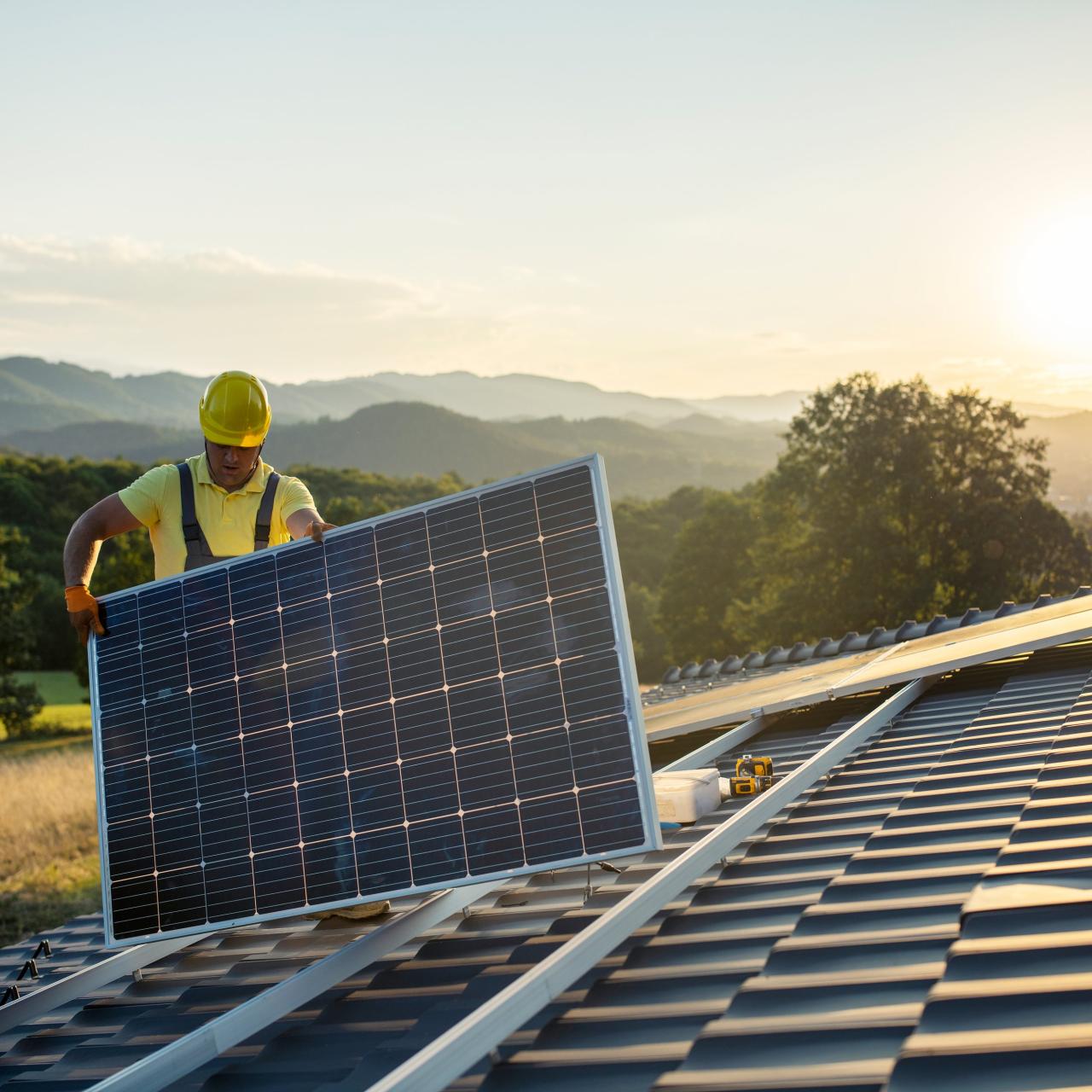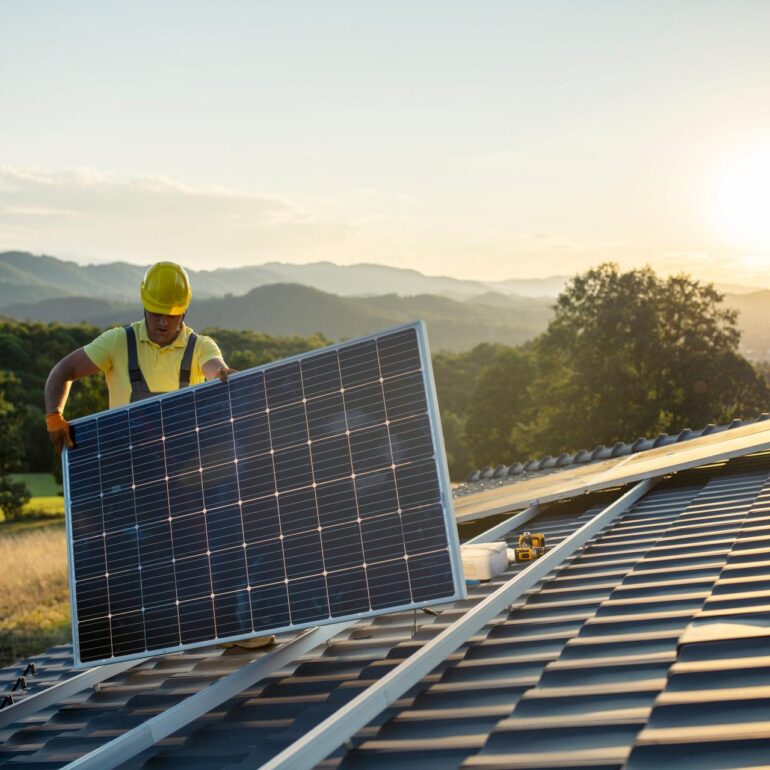How the Inflation Reduction Act will fight climate change focuses on significant investments in renewable energy, energy efficiency, electric vehicles, clean energy research, carbon capture, and international cooperation. The IRA offers a multi-pronged approach, aiming to reduce emissions and stimulate economic growth through incentives and funding opportunities. This comprehensive strategy targets various sectors, from individual homeowners to large industries, aiming to make a tangible impact on climate change.
The Act’s key provisions include substantial tax credits and grants for solar and wind installations, encouraging the transition to renewable energy sources. Energy efficiency improvements in buildings are also incentivized, aiming to reduce overall energy consumption and lower carbon emissions. Further, the IRA supports the expansion of electric vehicle infrastructure, fostering a shift towards cleaner transportation. These combined efforts contribute to a broader strategy that seeks to reduce carbon emissions across multiple fronts.
Investment in Renewable Energy
The Inflation Reduction Act (IRA) presents a significant opportunity for accelerating the transition to renewable energy sources. By incentivizing investments in solar and wind power, the act aims to bolster the domestic renewable energy sector and reduce reliance on fossil fuels. This shift is crucial for mitigating climate change and creating a more sustainable future.The IRA’s multifaceted approach to renewable energy focuses on making these technologies more accessible and economically viable for both homeowners and businesses.
This includes offering tax credits and grants, thereby reducing the upfront costs associated with installing renewable energy systems. This, in turn, can stimulate demand and foster innovation in the industry.
Renewable Energy Tax Credits Under the IRA
The IRA significantly expands and enhances existing tax credits for renewable energy installations, making them more attractive and accessible. This increased incentive is designed to boost the adoption of solar and wind power.
- Residential Solar Investment Tax Credit: This credit offers a 30% tax credit for the installation of qualified solar electric systems. This incentivizes homeowners to invest in solar panels, reducing their financial burden and making solar power a more affordable option.
- Commercial Renewable Energy Production Tax Credit: Businesses can claim a tax credit for renewable energy production, such as solar and wind farms. This encourages companies to invest in larger-scale renewable energy projects. The credit is often calculated based on the amount of electricity generated.
- Energy Efficiency Improvements Tax Credit: This is a significant aspect of the IRA, not solely focused on renewable energy but also includes energy-efficient improvements. Such improvements often reduce energy consumption, which is tied to the overall cost of operating a building. For instance, a business or home can qualify for credits on energy-efficient windows, insulation, and HVAC systems. These improvements, in conjunction with renewable energy installations, create a comprehensive approach to energy sustainability.
Estimated Financial Benefits
The IRA’s incentives can translate into substantial financial benefits for homeowners and businesses. These benefits vary depending on the size of the project and the specific technologies employed.
- Homeowners: For a typical residential solar installation, a 30% tax credit can substantially reduce the cost. For example, if the installation costs $20,000, the tax credit would amount to $6,000. This can make a significant difference in the overall affordability of renewable energy.
- Businesses: Businesses with large-scale solar or wind projects can see substantial financial savings. The tax credits can offset a substantial portion of the investment costs. This can help businesses reduce their energy bills and improve their bottom line while supporting a cleaner energy future. For instance, a manufacturing plant installing a large-scale solar array could realize significant long-term savings in energy costs.
Comparison with Other Policies
The IRA’s incentives for renewable energy can be compared to existing and previous policies to assess their impact.
| Policy | Incentive Type | Example |
|---|---|---|
| Investment Tax Credit (ITC) | Federal tax credit | 30% credit for qualified solar electric systems |
| Production Tax Credit (PTC) | Federal tax credit | Credit for electricity generated from renewable sources |
| Other State and Local Incentives | State and local tax credits and rebates | Rebates for residential solar installations |
The IRA’s comprehensive approach, incorporating various incentives, aims to create a more attractive investment climate for renewable energy, thus promoting a rapid shift towards a cleaner energy future.
Energy Efficiency Improvements: How The Inflation Reduction Act Will Fight Climate Change
The Inflation Reduction Act (IRA) recognizes the crucial role of energy efficiency in mitigating climate change and reducing energy costs. By incentivizing upgrades in buildings and infrastructure, the IRA aims to lower carbon emissions and create a more sustainable energy future. This focus on energy efficiency complements the IRA’s investment in renewable energy sources.
Energy Efficiency Upgrades Incentivized
The IRA offers incentives for a range of energy efficiency upgrades. These include improvements in building insulation, such as adding more insulation to walls, attics, and roofs, to reduce heat loss and gain. The act also encourages the installation of energy-efficient appliances, such as refrigerators, washing machines, and dishwashers, which significantly reduce energy consumption. These upgrades can significantly impact overall energy use and environmental footprint.
Potential Impact on Energy Consumption and Carbon Emissions
By promoting energy-efficient upgrades, the IRA directly addresses the issue of energy consumption. Improved insulation in buildings reduces the need for heating and cooling, resulting in lower energy demands. Similarly, energy-efficient appliances lessen the overall household energy consumption. This reduced energy consumption translates to a substantial decrease in carbon emissions, contributing to a cleaner environment.
Comparison with Existing Regulations
The IRA’s energy efficiency provisions build upon existing regulations but introduce more substantial incentives and broader coverage. The act aims to exceed the standards set by previous legislation, particularly concerning appliance efficiency and building codes. For example, it incentivizes exceeding minimum standards for insulation, aiming to further reduce energy consumption.
Economic Benefits
The IRA’s emphasis on energy efficiency offers considerable economic advantages. Businesses and consumers can benefit from reduced energy costs. By lowering energy bills, businesses can increase profitability and competitiveness, while homeowners and renters can save money on their utility expenses. This cost reduction can be significant, impacting household budgets and business profitability.
Incentives and Eligibility Criteria
| Improvement Type | Incentive Details | Eligibility Criteria |
|---|---|---|
| Building Insulation | Tax credits for improvements in insulation in residential and commercial buildings. | Specific insulation types, contractors, and project sizes may be specified. |
| Energy-Efficient Appliances | Tax credits or rebates for purchasing and installing energy-efficient appliances. | Appliance models must meet specific efficiency standards set by the EPA. |
| Energy-Efficient Lighting | Incentives for upgrading to LED lighting in commercial and residential buildings. | Building types and size may be part of eligibility criteria. |
| High-Efficiency HVAC Systems | Tax credits for replacing or installing high-efficiency HVAC systems. | Compliance with specific efficiency standards is crucial for eligibility. |
The above table provides a general overview. Specific details and eligibility criteria may vary based on the specific upgrade and location. Consult official IRS resources for detailed information.
Electric Vehicle (EV) Infrastructure
The Inflation Reduction Act (IRA) recognizes the crucial role of electric vehicle (EV) infrastructure in accelerating the transition to a cleaner energy future. It acknowledges that widespread EV adoption hinges on readily available and accessible charging stations, encouraging broader market participation. This focus on charging infrastructure is a critical component of the Act’s overall strategy to reduce greenhouse gas emissions.The IRA’s investment in EV charging stations is not simply about building more charging ports; it’s about strategically upgrading and expanding the existing network, making it more efficient and convenient for EV owners.
This proactive approach anticipates the growing demand for EV charging, addressing potential bottlenecks and ensuring seamless adoption. The initiative directly supports the development of a sustainable transportation system.
Funding Allocation for EV Charging Station Development
The IRA allocates significant funding for the construction and expansion of EV charging networks across the United States. This funding aims to improve accessibility and reduce the range anxiety often associated with EV ownership. The plan is designed to create a national network of charging stations that meet the needs of both individual drivers and long-distance travelers.
Support for Construction and Expansion of EV Charging Networks
The IRA provides incentives and funding for private sector investment in EV charging stations. These incentives include tax credits and grants, making the construction of charging stations more financially attractive for businesses and entrepreneurs. By lowering the barriers to entry, the IRA fosters the development of a more robust and widespread charging network.
Comparison with Existing Strategies
Existing strategies for developing EV charging infrastructure have often been fragmented and inconsistent. The IRA, by contrast, establishes a national framework for EV charging station development. This standardized approach will facilitate interoperability among different charging networks, ensuring a seamless experience for EV drivers regardless of the specific charging provider.
Potential Benefits of Increased EV Adoption
Increased EV adoption is expected to lead to a significant reduction in greenhouse gas emissions from the transportation sector. Switching from gasoline-powered vehicles to EVs directly lowers the carbon footprint of individual commuters and businesses. This shift is essential for achieving broader environmental goals.
Potential for New Jobs and Economic Growth
The development of EV charging infrastructure creates new jobs in construction, maintenance, and operation. Furthermore, the growing EV market stimulates related industries such as battery production and vehicle manufacturing, fostering economic growth and innovation. This represents a considerable opportunity for job creation across diverse sectors.
Proposed Funding Allocation for EV Charging Station Projects by Region
| Region | Estimated Funding Allocation (USD) |
|---|---|
| Northeast | $5 billion |
| Midwest | $4 billion |
| South | $3.5 billion |
| West | $3 billion |
Note: These figures are illustrative and represent potential allocations based on factors like existing charging infrastructure needs, population density, and projected EV adoption rates. Actual allocations may vary based on specific project proposals and priorities.
Clean Energy Technology Research and Development
The Inflation Reduction Act (IRA) prioritizes investment in clean energy technologies, recognizing that breakthroughs in research and development (R&D) are crucial for accelerating the transition to a sustainable energy future. This focus on innovation aims to reduce the cost and enhance the efficiency of clean energy sources, ultimately making them more competitive with traditional fossil fuel-based technologies.The IRA’s R&D investments are designed to foster breakthroughs in various clean energy areas, paving the way for a wider adoption of sustainable practices and solutions.
This commitment to technological advancement complements existing initiatives and encourages further innovation, thereby contributing to a cleaner and more resilient energy landscape.
The Inflation Reduction Act is aiming to tackle climate change head-on, with various initiatives like tax credits for renewable energy. Meanwhile, Best Buy is hosting a rare Apple shopping event with fantastic deals on Macs, iPads, and Apple Watches, offering a great opportunity to snag some tech upgrades. While saving money on tech is always a plus, it’s important to remember that the Act’s focus on clean energy and sustainable practices is vital in the fight against climate change.
best buy kicks off rare apple shopping event with deals on mac ipad apple watch and more This is just a short-term consumerist moment; long-term, investing in climate change solutions is crucial.
IRA Investments in Clean Energy Research and Development
The IRA allocates substantial funding to research and development projects in numerous clean energy areas. These investments span a wide spectrum of technologies, from advanced battery chemistries to carbon capture and storage. This strategic approach aims to create a robust ecosystem for innovation and accelerate the commercialization of clean energy technologies.
Targeted Clean Energy Technologies
The IRA specifically targets several crucial clean energy technologies for R&D. These include:
- Advanced Batteries: Research into next-generation battery technologies, including solid-state batteries and improved lithium-ion chemistries, is a key focus. These advancements are crucial for electric vehicles, energy storage systems, and grid modernization.
- Carbon Capture and Storage (CCS): The IRA recognizes the importance of capturing and storing carbon dioxide emissions from industrial sources and power plants. Research in this area aims to develop more efficient and cost-effective CCS technologies.
- Advanced Solar Technologies: The IRA supports research into more efficient and cost-effective solar cell materials and manufacturing processes, which can lead to higher energy yields and reduced production costs.
- Fusion Energy: Research in fusion energy, while still in its early stages, holds the promise of a virtually limitless clean energy source. The IRA supports this research, recognizing its long-term potential.
Examples of Research Projects and Institutions
The IRA’s funding will benefit numerous research institutions and projects across the country. For instance, funding for advanced battery research may support projects at national labs like the Argonne National Laboratory, while carbon capture research may be undertaken by universities and private companies. Examples of specific projects and institutions are difficult to enumerate due to the ongoing nature of research funding announcements.
Long-Term Impact on Technological Advancements
The IRA’s investment in clean energy R&D is expected to accelerate technological advancements in several critical areas. This could lead to faster development of cost-effective clean energy technologies, making them more accessible and widely adopted. This acceleration will, in turn, contribute to a reduction in greenhouse gas emissions and a more sustainable energy future.
Potential Impact on Reducing the Cost of Clean Energy Technologies, How the inflation reduction act will fight climate change
Through increased R&D, the IRA aims to significantly reduce the cost of clean energy technologies. By fostering innovation and competition in these areas, the IRA aims to make clean energy options more affordable, thus driving wider adoption and accelerating the transition away from fossil fuels. Lower costs will translate to greater consumer appeal and incentivize further investment.
The Inflation Reduction Act aims to tackle climate change head-on, focusing on clean energy incentives and investments. While the Act tackles big issues, it’s also important to protect your tech. Finding the perfect case for your Moto G6 is key, and luckily, checking out the best leather cases moto g6 will help you find the right one.
Ultimately, these investments in sustainable practices will help us achieve a healthier planet for the future.
Comparison of IRA Funding Levels with International Initiatives
| Initiative | Funding Level (Estimated) | Focus Areas |
|---|---|---|
| Inflation Reduction Act (IRA) | $xxx billion (approximate) | Advanced batteries, CCS, solar, fusion |
| European Union’s Green Deal Initiatives | $yyy billion (approximate) | Renewable energy, energy efficiency, circular economy |
| China’s Renewable Energy Initiatives | $zzz billion (approximate) | Solar, wind, hydropower, energy storage |
Note: Exact funding levels and focus areas for international initiatives may vary and are subject to change.
Carbon Capture and Storage

The Inflation Reduction Act (IRA) recognizes the crucial role of carbon capture and storage (CCS) in mitigating climate change. This technology aims to trap carbon dioxide emissions from industrial sources before they enter the atmosphere, potentially significantly reducing the carbon footprint of various sectors. While CCS is not a panacea, its strategic implementation can contribute meaningfully to emission reduction targets.
IRA Provisions for Carbon Capture
The IRA provides significant incentives and funding opportunities for companies investing in and deploying carbon capture technologies. These incentives are designed to encourage innovation and scale-up, making CCS more economically viable. The act targets industrial facilities that emit substantial amounts of carbon dioxide, fostering a more comprehensive approach to emission reduction.
The IRA includes tax credits and other financial incentives to support the development and deployment of carbon capture technologies.
The Inflation Reduction Act is aiming to tackle climate change head-on, focusing on clean energy incentives and emissions reductions. While that’s happening, it’s also interesting to see how private sector players like Jeff Bezos, who’s involved in Jeff Bezos Donald Trump election Amazon climate change fund , are getting involved in similar efforts. Ultimately, the Act is a crucial step toward a sustainable future, and private initiatives can complement and accelerate this transition.
Incentives and Funding Opportunities
The IRA offers various financial incentives for companies implementing carbon capture. These incentives can include tax credits, grants, and loan guarantees. The specific incentives are often tied to the scale and efficiency of the capture systems. For instance, companies demonstrating technological advancements or significant reductions in emissions are often eligible for larger incentives. Furthermore, the IRA encourages public-private partnerships, which can unlock additional funding sources.
- Tax credits for carbon capture equipment and infrastructure investments.
- Grants and loans for pilot projects and demonstration plants.
- Funding for research and development to improve carbon capture technologies.
- Potential for dedicated funding streams to support the deployment of CCS in specific industrial sectors.
Role of Carbon Capture in Industrial Emission Reduction
Industrial facilities, such as power plants, cement factories, and steel mills, are significant sources of carbon dioxide emissions. Carbon capture technologies can play a vital role in reducing emissions from these facilities. By capturing the CO2 emitted during industrial processes, CCS can substantially lower their environmental impact. The successful implementation of these technologies in industrial settings will be critical to achieving broader emission reduction targets.
Environmental and Economic Benefits
Carbon capture offers significant environmental benefits by reducing greenhouse gas emissions. This can lead to a cleaner environment and potentially mitigate the effects of climate change. Economically, CCS can create jobs in the manufacturing, installation, and maintenance of the necessary infrastructure. Moreover, it can unlock new markets for captured CO2, potentially leading to valuable by-products. For example, captured CO2 can be used in various industrial processes or stored underground.
Challenges of Large-Scale CCS Implementation
Despite its potential, large-scale implementation of carbon capture faces several challenges. These include the high capital costs associated with CCS infrastructure, the need for robust storage capacity, and the potential for leakage during storage. Furthermore, public acceptance of CCS projects can be an issue in certain areas due to concerns about potential risks. Overcoming these challenges is crucial for the widespread adoption of carbon capture technologies.
Key Aspects of the IRA’s Carbon Capture Provisions
- Tax credits for carbon capture equipment and infrastructure investments, with varying levels of credit depending on the capture technology and its efficiency.
- Funding for research and development to advance carbon capture technologies and improve their economic viability.
- Incentives to promote public-private partnerships and collaboration between industrial facilities, technology developers, and government agencies to accelerate deployment.
- Emphasis on the use of existing infrastructure and facilities for carbon capture, where feasible, to minimize additional costs and environmental impact.
International Climate Cooperation

The Inflation Reduction Act (IRA) recognizes the global nature of climate change, acknowledging that effective solutions require international collaboration. This section delves into the IRA’s strategies for fostering international partnerships, analyzing their potential impact on global efforts, and comparing them with other initiatives. The core principle driving these strategies is the understanding that a collective response is vital to achieving meaningful climate mitigation.The IRA aims to bolster international climate cooperation through financial incentives and technical assistance, recognizing that global challenges necessitate global solutions.
These approaches are designed to encourage other countries to adopt similar policies and technologies, accelerating the transition to a cleaner energy future.
IRA’s Strategies for International Climate Cooperation
The IRA promotes international climate cooperation through various avenues, including financial mechanisms, technical assistance, and the encouragement of international standards. These efforts are grounded in the understanding that shared challenges necessitate shared solutions.
- Financial Mechanisms: The IRA includes provisions for international climate finance, such as grants and loans for developing countries to adopt renewable energy technologies and sustainable practices. This approach recognizes that developing nations often require financial support to implement impactful climate solutions. Examples include programs to support the development of renewable energy infrastructure in developing countries.
- Technical Assistance: The IRA facilitates the transfer of clean energy technologies and expertise to developing countries. This aims to empower these nations with the necessary knowledge and resources to transition to cleaner energy sources. Such assistance can include providing training programs for technicians and engineers in renewable energy technologies.
- Promoting International Standards: The IRA encourages the development and adoption of international standards for clean energy technologies, aiming for greater harmonization and interoperability. This approach facilitates the exchange of knowledge and expertise and allows for a more efficient global transition.
Potential Impact on Global Efforts
The IRA’s strategies for international climate cooperation have the potential to significantly boost global efforts to address climate change. By providing financial and technical support to developing nations, the IRA can encourage a global shift towards cleaner energy. This can lead to significant reductions in greenhouse gas emissions worldwide, accelerating the transition to a sustainable future.
Comparison with Other Initiatives
The IRA’s approach to international climate cooperation can be compared to initiatives from other countries and international organizations. The European Union’s Green Deal, for example, emphasizes similar goals of promoting clean energy and sustainable practices, but often with different strategies and priorities. The Paris Agreement sets a framework for international climate action, and the IRA aims to bolster its implementation.
Benefits of Global Collaboration
Global collaboration on climate change mitigation offers significant advantages. The combined resources, expertise, and technological advancements of nations working together can accelerate the development and deployment of clean energy technologies. This collaborative approach is essential to effectively address the global challenge of climate change. International partnerships create a multiplier effect, amplifying the impact of individual actions.
Impact of International Partnerships on Mitigation Efforts
International partnerships foster innovation and knowledge sharing, accelerating the development and adoption of climate-friendly technologies. Collaboration facilitates the exchange of best practices and technical expertise, allowing for a more rapid transition to a sustainable energy system. For example, a joint project between the US and India on carbon capture and storage could lead to advancements in this critical technology, benefiting both countries and the global community.
IRA’s Investments in International Climate Projects
| Project Area | Estimated Investment (USD) | Target Countries/Regions |
|---|---|---|
| Renewable Energy Deployment in Developing Countries | $5 Billion | Africa, Asia, Latin America |
| Clean Energy Technology Transfer | $2 Billion | Global |
| International Climate Research and Development | $1 Billion | Global |
Outcome Summary
The Inflation Reduction Act’s multifaceted approach to tackling climate change promises a significant impact on the environment and economy. By incentivizing renewable energy, boosting energy efficiency, and expanding electric vehicle infrastructure, the Act positions the US to lead the transition towards a cleaner energy future. While challenges remain, the IRA’s comprehensive strategy, including investments in research and international partnerships, suggests a concerted effort to combat climate change effectively.
The long-term benefits of these initiatives are likely to be substantial.




